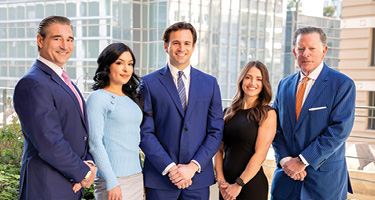Catastrophic Neurological Injuries in Civil Litigation
Traumatic injuries to the head and spinal cord represent some of the most complex cases in personal injury law, often resulting in permanent disability, cognitive impairment, or paralysis. The Centers for Disease Control reports that traumatic brain injuries alone contribute to approximately 30% of all injury-related deaths in the United States. These injuries create extensive medical challenges that extend far beyond the initial trauma, requiring comprehensive rehabilitation, long-term medical supervision, and often permanent lifestyle modifications.
The financial burden associated with severe neurological injuries frequently exceeds millions of dollars over a lifetime. Victims may lose their ability to work, require constant medical supervision, or need extensive home modifications to accommodate their physical limitations. The complexity of these cases demands meticulous preparation and extensive documentation to establish both the full extent of damages and the responsible party's liability.
Civil litigation serves as a mechanism for victims to seek compensation for the resources necessary for proper care and rehabilitation. However, these cases require collaboration between legal professionals, medical experts, and financial specialists to ensure comprehensive case development. A personal injury case involving neurological damage requires detailed analysis of medical records, expert testimony, and economic projections to accurately reflect the long-term impact of these injuries. The complexity of proving causation and projecting future needs makes thorough legal representation important for achieving appropriate recovery.
Legal practitioners must navigate complex medical evidence while addressing insurance company challenges regarding causation, pre-existing conditions, and the extent of claimed damages. The invisible nature of many neurological symptoms requires sophisticated presentation of medical evidence to establish the connection between the incident and resulting impairments.
Proving Liability in Traumatic Brain Injury Cases
Traumatic brain injuries present unique challenges in civil litigation because their effects often remain invisible to casual observation. Unlike broken bones or external wounds, brain injuries can produce subtle but profound changes in personality, cognition, and emotional regulation that may not become apparent until weeks or months after the incident. These delayed manifestations can complicate efforts to establish causation, particularly when insurance companies or opposing counsel attempt to attribute symptoms to pre-existing conditions or unrelated factors.
Motor vehicle accidents represent the leading cause of traumatic brain injuries among adults, followed by falls and workplace incidents. In each scenario, the mechanism of injury becomes crucial to establishing liability. Brain injury lawyers often rely on accident reconstruction experts and biomechanical engineers to demonstrate how the forces involved in an incident could produce the observed neurological damage. This scientific approach becomes particularly important when dealing with mild traumatic brain injuries that may not show obvious signs on standard imaging studies.
The process of building a compelling case requires gathering evidence from multiple sources. Medical records, neuropsychological testing results, and brain imaging studies form the foundation, but witness testimony from family members and coworkers often provides compelling evidence of how the injury has changed the victim's life. These individuals can describe personality changes, memory problems, or cognitive difficulties that medical tests might not fully capture. Additionally, employment records and academic transcripts can demonstrate a decline in performance that correlates with the timing of the injury.
Expert medical testimony plays a pivotal role in explaining complex neurological concepts to judges and juries. Neurologists and neuropsychologists must translate technical findings into language that lay people can comprehend while maintaining scientific accuracy. They explain how specific areas of brain damage correlate with observed symptoms and why certain deficits may be permanent rather than temporary. This educational component of the case often determines whether the jury fully grasps the severity and permanence of the plaintiff's condition.
Spinal Cord Injury Litigation and Comprehensive Damage Assessment
Spinal cord injuries rank among the most catastrophic forms of personal injury, often resulting in complete or partial paralysis that fundamentally alters the victim's daily life. These injuries typically occur in situations involving significant trauma, such as motor vehicle collisions, construction accidents, or incidents involving defective products. The immediate medical costs alone can reach hundreds of thousands of dollars, but the lifetime expenses for comprehensive care often exceed several million dollars, particularly for injuries resulting in quadriplegia.
A spinal cord injury attorney must thoroughly investigate the circumstances surrounding the injury to identify all potentially liable parties. In many cases, multiple defendants may bear responsibility for the incident. For example, a construction site accident might involve the property owner, general contractor, equipment manufacturer, and various subcontractors. Each party's insurance coverage and financial resources must be evaluated to ensure adequate compensation remains available to meet the victim's long-term needs.
The assessment of damages in spinal cord injury cases requires extensive collaboration with medical professionals, rehabilitation specialists, and economists. Life care planners develop comprehensive projections that account for ongoing medical treatment, adaptive equipment, home modifications, and personal care assistance. These projections must consider the victim's age, level of injury, and pre-injury lifestyle to accurately reflect future needs. Additionally, vocational rehabilitation experts evaluate the impact on earning capacity, often finding that even highly educated individuals may face significant limitations in their ability to return to employment.
Legal teams must also address secondary health complications that commonly arise with spinal cord injuries. These may include respiratory problems, skin breakdown, autonomic dysfunction, and psychological conditions such as depression or anxiety. Each complication adds complexity to the medical picture and increases the overall cost of care. Establishing that these secondary conditions result from the original injury rather than independent causes requires careful medical analysis and expert testimony.
Evidence preservation becomes critical in spinal cord injury cases due to the complexity involved. This includes securing accident scene photographs, witness statements, vehicle data recorders, and any relevant surveillance footage before it disappears or becomes altered. Medical records from the initial treatment must be obtained immediately, as these often contain crucial information about the severity of the injury and the treating physicians' initial impressions about prognosis.
Wrongful Death Claims Following Fatal Head Trauma
When traumatic head injuries result in death, the legal focus shifts to the impact on surviving family members. These cases present unique challenges because the person who could best describe the accident circumstances is no longer available to provide testimony. Wrongful death attorneys must reconstruct not only the events leading to the fatal injury but also the full scope of losses experienced by the surviving family.
The calculation of damages in wrongful death cases requires careful analysis of the deceased person's role within the family structure. This extends beyond financial contributions to include the services they provided, such as childcare, household management, emotional support, and guidance. Economic experts evaluate the present value of lost earnings over what would have been the deceased's working lifetime, accounting for inflation, career advancement potential, and benefits. However, the non-economic losses often represent a significant component of damages, particularly when the deceased was a young parent or spouse.
Medical evidence plays a crucial role in establishing both causation and the degree of pain and suffering experienced before death. Autopsy reports, emergency medical records, and witness accounts help establish the circumstances of the deceased's final moments. In cases where the victim survived for a period after the injury, medical records documenting their condition become relevant to claims for conscious pain and suffering.
A wrongful death lawyer must also navigate the relationships within families to determine who qualifies as a beneficiary under state law. Different jurisdictions have varying rules about which family members can recover damages and what types of losses they can claim. Spouses and minor children typically have claims, but adult children, parents, and other dependents may also be entitled to compensation depending on their relationship with the deceased and their degree of financial or emotional dependence.
The emotional aspects of these cases require sensitive handling while maintaining the advocacy necessary to seek appropriate compensation. Families often struggle with grief and overwhelming emotions while simultaneously trying to make important legal decisions. Effective legal representation involves not only pursuing financial recovery but also helping families access appropriate support services during this difficult period.
Consortium Claims and Family Impact Beyond the Primary Victim
Catastrophic head and spinal cord injuries affect more than just the primary victim. Spouses, children, and other close family members often experience profound changes in their relationships and daily lives that may warrant consideration within the legal system. Loss of consortium claims allow these secondary victims to seek damages for the harm they have suffered as a result of their loved one's injury.
The concept of consortium encompasses both the tangible and intangible aspects of family relationships. For spouses, this includes the loss of companionship, affection, and mutual support that formed the foundation of their marriage. When a traumatic brain injury significantly alters a person's personality or cognitive abilities, their spouse may find that the person they married is no longer able to provide emotional support, make decisions, or participate in family activities.
Children face particular challenges when a parent suffers a severe neurological injury. They may lose not only financial support but also guidance, discipline, educational assistance, and emotional nurturing. Older children might find themselves thrust into caregiving roles, potentially sacrificing their own educational or career opportunities to help manage household responsibilities. These impacts extend far into the future and can affect the children's own development and life choices.
Proving consortium damages requires intimate testimony about private family relationships that many people find difficult to discuss in a public courtroom. Family members must describe how their relationships have changed, what activities they can no longer enjoy together, and how the injury has affected their emotional well-being. This testimony, while necessary, can be emotionally challenging for family members who are already coping with significant stress and adjustment.
Legal teams must carefully balance the need to fully document these losses with sensitivity to the family's privacy and emotional state. Often, this involves working with mental health professionals who can evaluate and testify about the psychological impact on family members while helping them cope with their situation. Support groups and counseling services may provide additional evidence of the ongoing challenges faced by these secondary victims.
Financial Recovery Through Legal Accountability
Civil litigation for catastrophic neurological injuries demands legal knowledge and comprehensive case development to achieve outcomes that address the victim's long-term needs. The complexity of these cases requires coordination between multiple professionals, including medical experts, economists, life care planners, and rehabilitation specialists, all working toward securing appropriate compensation.
The litigation process typically begins with a thorough investigation of the incident that caused the injury. This involves collecting physical evidence, interviewing witnesses, and consulting with experts who can analyze the circumstances and explain how the injury occurred. In many cases, the investigation reveals multiple parties who may bear some responsibility for the incident, requiring careful analysis of each party's role and insurance coverage.
Personal injury lawyers handling these cases must possess both the resources and knowledge necessary to develop complex medical and financial evidence. This often involves substantial upfront investment in expert witnesses, medical records, and testing that may be needed to fully document the extent of injuries and their impact. The ability to finance this investigation and case development while the case proceeds through the legal system represents an important factor in achieving favorable outcomes.
Settlement negotiations in catastrophic injury cases require careful strategy and timing. Insurance companies often attempt to resolve cases quickly, before the full extent of injuries and their long-term consequences become apparent. Attorneys may resist pressure to settle prematurely, ensuring that medical treatment has been completed and the long-term prognosis is clear before engaging in serious settlement discussions. This approach often results in higher recovery amounts that better reflect the true cost of the injury.
When cases proceed to trial, the presentation of evidence becomes crucial. Juries must be educated about complex medical concepts while also developing an connection to the victim and their family. This requires careful preparation of both expert witnesses and lay witnesses who can explain the technical aspects of the case and the human impact of the injuries. Visual aids, day in the life videos, and other demonstrative evidence help juries comprehend the full scope of the plaintiff's losses.
Each personal injury case represents more than a legal dispute. These lawsuits serve important functions in promoting safety, holding negligent parties accountable, and providing the resources necessary for victims to access proper care. The compensation recovered through civil litigation enables access to medical treatment, adaptive equipment, home modifications, and ongoing care that might otherwise be unavailable. Successful litigation may also send a message that negligent conduct carries consequences, potentially preventing similar injuries to others in the future.
This content is for informational purposes only and does not constitute legal advice. No attorney-client relationship is formed by reading this article. Laws may vary by jurisdiction. Please consult a qualified attorney licensed in your state for legal guidance specific to your situation.















